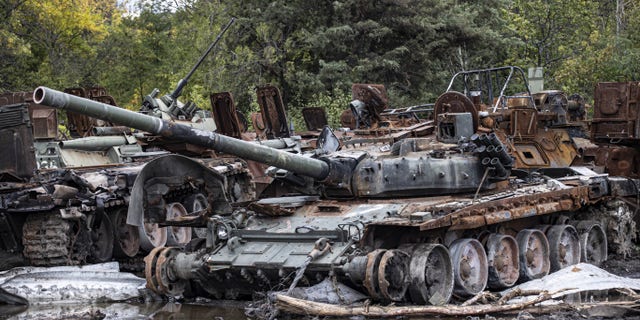The war in Ukraine has revealed how the digital age is leveling the playing field between great powers and smaller countries. Ukraine has skillfully deployed precision munitions, drone technology and sophisticated encrypted software to gain the upper hand against Russia’s invading conventional military, but Russian President Vladimir Putin’s most recent remarks, and his move to illegally annex portions of Ukraine, make it clear that digital warfare will also unleash a second nuclear age.
Western technology, including encrypted command and control, the High Mobility Artillery Rocket System (HIMARS), drone and counter-drone systems, combined with Ukrainian savvy and resolve have arrested Russian advances and recently rolled back Russian gains. Chips and software have proven more potent than tanks and soldiers. “The lesson for every big country is ‘holy s—,” Palantir CEO Alex Karp recently told CNBC.
Pushed back toward his own borders and facing the prospect of a humiliating defeat, Putin is now threatening the unthinkable. “If the territorial integrity of our country is threatened,” he warned, “we will certainly use all the means at our disposal to protect Russia and our people.”
BIDEN INVOKES POSSIBILITY OF ‘ARMAGEDDON’ IN DEMOCRATIC FUNDRAISER SPEECH
Putin has rattled his nuclear saber before. But this time is different. This time he’s losing a war, and the calculation is as simple as it is alarming: Software beats steel, but nuclear weapons beat all.

Destroyed Russian armored vehicles left behind by the Russian forces in Izium, Kharkiv, Ukraine on October 02, 2022. (Photo by Metin Aktas/Anadolu Agency via Getty Images)
(getty images)
Technologists have feared this outcome. As the war unfolded, prominent U.S. tech entrepreneurs traveled to Ukraine to witness firsthand how a digital military can defeat a conventional power. They understand more than anyone that the war we are seeing involves capabilities and concepts that until now were relegated to think-tank papers, war-game simulations and military proving grounds. The system that for eight decades prevented nuclear war is no longer the system in which armies operate.
Warfare of the 21st Century is being determined less by the size of an army and more by the speed and efficiency of what experts call the kill chain: the network of software-driven systems that enable the military to understand threats rapidly, identify targets and strike the adversary using satellites, autonomous systems and artificial intelligence. In its fight against Russia, Ukraine has cobbled together the superior kill chain.
But Karp and others observed that the longer the conflict, the more desperate Putin becomes, the more likely it is that nuclear weapons will enter the battlefield. And Putin is desperate, now resorting to calling up 300,000 reservists, prompting many Russians to purchase one-way tickets out of the country.
This was all foreseeable, yet military planners and nuclear strategists have not adequately prepared. Rather than adopting a nuclear posture and developing capabilities that could deter an adversary from escalating to a nuclear strike, the Biden administration remains stuck in the immediate post–Cold War mindset that prioritized arms control negotiations and hesitated to develop new battlefield nuclear weapons.
The Trump administration attempted to get ahead of this problem by exiting the Intermediate-Range Nuclear Forces Treaty. Russia had already abrogated its treaty obligations, and China — not a party to the Cold War era treaty — has been moving forward building a sophisticated tactical nuclear arsenal, leaving the United States at a dangerous disadvantage by tying its own hands.
CLICK HERE TO GET THE OPINION NEWSLETTER
Additionally, plans to add nuclear-capable cruise missiles to our military arsenal have been stymied by some who view any development of nuclear weapons as a threat to peace rather than a necessary tool to keep the peace.
Alarmingly, some in the Biden administration pushed for the United States to depart from its current declaratory policy and instead adopt a “no first use” policy — declaring to the world that the United States would never take the first shot, no matter how grave the threat. If adopted, this policy would remove our nuclear arsenal’s deterrent effects. A no-first-use policy would weaken the United States and its allies before Russian tanks rolled into Ukraine this past winter. But now, such a move would be seen as an invitation to Russia to launch a nuclear strike on Ukraine.
CLICK HERE TO GET THE FOX NEWS APP
The stakes are even higher because this threat is not unique to Russia. Attributing Putin’s escalation solely to his ill-equipped and poorly trained military misses the paradigmatic shift the war has revealed: digitally powered weapons can thwart an invading conventional army — even a well-trained and equipped one. This scenario will arise again when a digital military stymies another revanchist nuclear power. Putin is betting the West may fear a new era of nuclear brinksmanship more than a Russian-occupied Ukraine.
How the free world responds to Putin will determine the nuclear playbook that Iran, China and North Korea use in the future. The digital age has created a second nuclear age. The world has changed. So, must America’s nuclear strategy.










